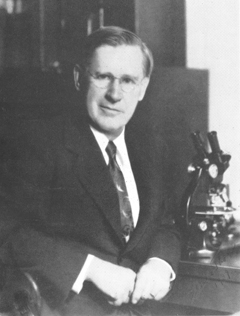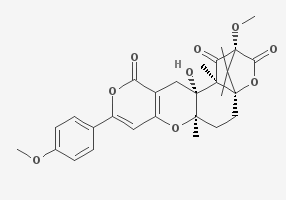
Aspergillus niger is a fungus and one of the most common species of the genus Aspergillus.

Aspergillus flavus is a saprotrophic and pathogenic fungus with a cosmopolitan distribution. It is best known for its colonization of cereal grains, legumes, and tree nuts. Postharvest rot typically develops during harvest, storage, and/or transit. Its specific name flavus derives from the Latin meaning yellow, a reference to the frequently observed colour of the spores. A. flavus infections can occur while hosts are still in the field (preharvest), but often show no symptoms (dormancy) until postharvest storage and/or transport. In addition to causing preharvest and postharvest infections, many strains produce significant quantities of toxic compounds known as mycotoxins, which, when consumed, are toxic to mammals. A. flavus is also an opportunistic human and animal pathogen, causing aspergillosis in immunocompromised individuals.

Aspergillus is a genus consisting of a few hundred mold species found in various climates worldwide.

Aspergillus oryzae, also known as kōji mold, is a filamentous fungus used in East Asia to saccharify rice, sweet potato, and barley in the making of alcoholic beverages such as sake and shōchū, and also to ferment soybeans for making soy sauce and miso. However, in the production of fermented foods of soybeans such as soy sauce and miso, Aspergillus sojae is mainly used instead of A. oryzae. A. oryzae is also used for the production of rice vinegars. Barley kōji (麦麹) or rice kōji (米麹) are made by fermenting the grains with A. oryzae hyphae.
Mycotoxicology is the branch of mycology that focuses on analyzing and studying the toxins produced by fungi, known as mycotoxins. In the food industry it is important to adopt measures that keep mycotoxin levels as low as practicable, especially those that are heat-stable. These chemical compounds are the result of secondary metabolism initiated in response to specific developmental or environmental signals. This includes biological stress from the environment, such as lower nutrients or competition for those available. Under this secondary path the fungus produces a wide array of compounds in order to gain some level of advantage, such as incrementing the efficiency of metabolic processes to gain more energy from less food, or attacking other microorganisms and being able to use their remains as a food source.

Aspergillus terreus, also known as Aspergillus terrestris, is a fungus (mold) found worldwide in soil. Although thought to be strictly asexual until recently, A. terreus is now known to be capable of sexual reproduction. This saprotrophic fungus is prevalent in warmer climates such as tropical and subtropical regions. Aside from being located in soil, A. terreus has also been found in habitats such as decomposing vegetation and dust. A. terreus is commonly used in industry to produce important organic acids, such as itaconic acid and cis-aconitic acid, as well as enzymes, like xylanase. It was also the initial source for the drug mevinolin (lovastatin), a drug for lowering serum cholesterol.
Blasticidin S is an antibiotic that is used in biology research for selecting cells in cell culture. Cells of interest can express the blasticidin resistance genes BSD or bsr, and can then survive treatment with the antibiotic. Blasticidin S is a nucleoside analogue antibiotic, resembling the nucleoside cytidine. Blasticidin works against human cells, fungi, and bacteria, all by disrupting protein translation. It was originally described by Japanese researchers in the 1950s seeking antibiotics for rice blast fungus.
Terreus, a Latin word meaning earth may refer to:

Charles Thom was an American microbiologist and mycologist. Born and raised in Illinois, he received his PhD from the University of Missouri, the first such degree awarded by that institution. He was best known for his work on the microbiology of dairy products and soil fungi, and in particular his research into the genera Aspergillus and Penicillium. His work influenced the establishment of standards for food handling and processing in the USA. He pioneered the use of culture media to grow microorganisms, and, with food chemist James N. Currie, developed a process to mass-produce citric acid using Aspergillus. Thom played an important role in the development of penicillin in World War II.

6-Hydroxymellein is a dihydroisocoumarin, a phenolic compound found in carrots. It has also been isolated in Aspergillus terreus and shows an inhibition of pollen development in Arabidopsis thaliana.

Terreulactone A is a meroterpenoid isolate of Aspergillus with anti-acetylcholinesterase activity.
Sinah Estelle Kelley was an American chemist who worked on the mass production of penicillin.

Aspergillus alabamensis is a soil fungus in the division Ascomycota first described in 2009 as a segregated taxon of A. terreus. Originally thought to be a variant of A. terreus, A. alabamensis is situated in a distinctive clade identified by genetic analysis. While A. alabamensis has been found to be morphologically similar to Aspergillus terreus by morphological studies, the two differ significantly in active metabolic pathways, with A. alabamensis producing the mycotoxins citrinin and citreoviridin but lacking mevinolin.
Aspergillus qinqixianii is a species of fungus in the genus Aspergillus which has been isolated from desert soil from the Taklimakan desert in China. It is from the Nidulantes section. Aspergillus qinqixianii produces asteltoxin, asperthecin, emericellin, 2-ω-hydroxyemodin, shamixanthones, terrein, curvularin and dehydrocurvularin.
Aspergillus novofumigatus is a species of fungus in the genus Aspergillus. It is from the Fumigati section. Several fungi from this section produce heat-resistant ascospores, and the isolates from this section are frequently obtained from locations where natural fires have previously occurred. The species was first described in 2006. It was isolated from soil from the Galapagos Islands. It has been shown to produce aszonalenin, cycloechinuline, fiscalins, helvolic acid, neosartorin, palitantin, terrein, and territrem B.
Aspergillus olivicola is a species of fungus in the genus Aspergillus. It is from the Nidulantes section. The species was first described in 2008. It has been isolated from fruit in Italy. A. olivicola has been shown to produce aflatoxin B1, emericellin, shamixanthone, siderin, sterigmatocystin, terrein, and varitriol.
Aspergillus karnatakaensis is a species of fungus in the genus Aspergillus. It is from the Aenei section. The species was first described in 2010. A. karnatakaensis has been isolated from soil, and has been found to produce terrein, gregatins, asteltoxin, karnatakafuran A, and karnatakafuran B.
Aspergillus pseudoterreus is a species of fungus in the genus Aspergillus. It is from the Terrei section. The species was first described in 2011. It has been reported to produce aspulvinones, asterriquinones, butyrolactones, citreoisocoumarin, citreoviridin, citrinin, 3-methylorsellinic acid, terrein, and terrequinone A.
Aspergillus hortai is a species of fungus in the genus Aspergillus. It is from the Terrei section. The species was first described in 1935. It has been isolated from the ear of a human in Brazil, soil from the Galapagos Islands, and soil from the United States. It has been reported to produce acetylaranotin, butyrolactones, citrinin, 3-methylorsellinic acid, terrein, and terrequinone A.
Aspergillus carneus is a fast-growing, filamentous fungus found on detritus and in fertile soil worldwide. It is characterized by its yellow, thick-walled hyphae and biseriate sterigmata. The fungus produces citrinin and 5 unique depsipeptides, Aspergillicins A-E.









